Brian Carter, Andie Parry, Amin Soltani, and Nicholas Carl
The Iran Update provides insights into Iranian and Iranian-sponsored activities abroad that undermine regional stability and threaten US forces and interests. It also covers events and trends that affect the stability and decision-making of the Iranian regime. The Critical Threats Project (CTP) at the American Enterprise Institute and the Institute for the Study of War (ISW) provides these updates regularly based on regional events. For more on developments in Iran and the region, see our interactive map of Iran and the Middle East.
Note: CTP and ISW have refocused the update to cover the Israel-Hamas war. The new sections address developments in the Gaza Strip, the West Bank, Lebanon, and Syria, as well as noteworthy activity from Iran’s Axis of Resistance. We do not report in detail on war crimes because these activities are well-covered in Western media and do not directly affect the military operations we are assessing and forecasting. We utterly condemn violations of the laws of armed conflict, Geneva Conventions, and humanity even though we do not describe them in these reports.
Key Takeaways:
- Palestinian militias continued attacks at their usual rate from the Gaza Strip into Israel. Palestinian militias increased their targeting of the Israel Defense Forces in these attacks, likely as part of their preparations to defend against a possible Israeli ground operation.
- Clashes between Palestinian militants and Israeli forces in the West Bank dropped by roughly half.
- Iranian-backed militants, including Lebanese Hezbollah, conducted 17 attacks as part of an ongoing attack campaign against Israeli forces and assets.
- Iranian leaders have reached a consensus approving limited cross-border Lebanese Hezbollah attacks into Israel, according to Reuters. This report and others indicate that Iran and Lebanese Hezbollah are coordinating a carefully calibrated escalation to draw Israeli attention away from the Gaza Strip.
- The Israel Defense Forces Air Force conducted airstrikes on the Damascus and Aleppo international airport runways. The Israeli Foreign Affairs Ministry indicated that the airstrikes in Syria are part of an Israeli effort to prevent Iran from moving weapons into Syria and/or opening a front against Israel from there.
- Islamic Revolutionary Guard Corps Quds Force Commander Brigadier General Esmail Ghaani arrived in Syria to monitor Iranian-backed militias on the Israel-Syria border, according to Israeli media. Ghaani previously warned Syrian President Bashar al Assad that Iran intends to use Syria as a second front if the war expands.
- The Islamic Resistance in Iraq—a coalition of Iranian-backed Iraqi militias—conducted a one-way drone attack on US forces at Ain al Asad air base in Iraq, marking the fifth consecutive day of attacks targeting US forces in the Middle East. These attacks are part of the Iranian-led effort to deter the United States from providing meaningful support to Israel.
- The Houthi prime minister said that the Houthis will target Israeli ships in the Red Sea if Israel continues operations in the Gaza Strip after meeting with Palestinian militia officials in Sanaa, Yemen.
Gaza Strip
Palestinian militias continued attacks at their usual rate from the Gaza Strip into Israel on October 22. The al Qassem Brigades—Hamas’ militant wing—claimed responsibility for 12 direct and indirect fire attacks.[1] Saraya al Quds—the militant wing of Palestinian Islamic Jihad (PIJ)—claimed responsibility for another three rocket attacks.[2] This rate of attacks is consistent with the rate that CTP-ISW has observed in recent days.
Palestinian militias in the Gaza Strip increased their targeting of the Israel Defense Forces (IDF), likely as part of their preparations to defend against a possible Israeli ground operation. Palestinian militias targeted a greater proportion of military targets relative to their overall attacks than at any point since October 18, when the militias targeted IDF positions near the Gaza Strip 15 times.[3] Palestinian militias launched eight direct and indirect fire attacks targeting the IDF on October 22.[4] They also fired mortars and rockets targeting Israeli cities and towns seven times. Al Qassem Brigades fighters separately killed one Israeli soldier and wounded three others during a firefight within the Gaza Strip.[5] The IDF said that the Israeli forces were searching for the bodies of missing Israelis and preparing for Israel’s ground operation.[6]
Recorded reports of rocket attacks; CTP-ISW cannot independently verify impact.
Recorded reports of rocket attacks; CTP-ISW cannot independently verify impact.
West Bank
Clashes between Palestinian militants and Israeli forces in the West Bank dropped by roughly half on October 22.[7] CTP-ISW recorded nine distinct clashes.[8] Al Aqsa Martyrs’ Brigade fighters clashed with Israeli forces in Qabatiya, close to Jenin, on October 22. The al Aqsa Martyrs‘ Brigade fighters used small arms and improvised explosive devices (IED) against Israeli forces.[9]
CTP-ISW recorded only two demonstrations in the West Bank on October 22, which is consistent with the number of demonstrations on October 21.[10] Hamas’ calls for protests in support of the Gaza Strip across the world did not generate increased protests in the West Bank.[11]
Israeli forces continued raids and arrests in the West Bank, arresting at least 46 Palestinians, including 27 active Hamas members and two PIJ military leaders, south of Jenin on October 22.[12]
This map is not an exhaustive depiction of clashes and marches in the West Bank.
Southern Lebanon and Golan Heights
Iranian-backed militants, including Lebanese Hezbollah (LH), conducted 17 attacks as part of an ongoing attack campaign against IDF forces and assets on October 22.[13] These attacks are consistent with the increased rate of Iranian-backed attacks into Israel since October 15. This campaign creates opportunities for additional Iranian-backed ground attacks into Israel and increases the risk of further escalation, as CTP-ISW previously noted.[14] LH militants fired surface-to-air missiles at an IDF helicopter, marking the first use of air defense in Lebanon against the IDF since the start of the war.[15] The IDF intercepted a drone crossing from Lebanon into Israel—the first attempted drone infiltration from Lebanon since October 20.[16] The majority of attacks from Lebanon used anti-tank guided missiles against IDF forces and positions.[17] Israeli forces struck five ATGM squads in southern Lebanon on October 22.[18]
The Israeli Defense Ministry expanded the civilian evacuation zone along the Israel-Lebanon border to encompass 14 additional towns.[19] Israel previously evacuated towns within two kilometers of the border.[20]
Several Iranian-backed militias are participating in the attack campaign against Israeli forces from southern Lebanon. The al Qassem Brigades fired multiple barrages of rockets at northern Israeli towns on October 15 and 19.[21] Saraya al Quds claimed four of its fighters have died in southern Lebanon since October 7.[22] LH has almost certainly approved these attacks given the extent to which LH controls southern Lebanon and coordinates with the other Iranian-backed groups operating there.
Iranian leaders have reached a consensus approving limited cross-border LH attacks into Israel, according to Reuters.[23] Two LH-affiliated individuals also told Reuters that the LH military activity around northern Israel is meant to ”keep Israeli forces busy but not open a major new front.” CTP-ISW cannot verify the accuracy of this report. It is consistent, however, with the IDF spokesperson stating that Iran has instructed LH to escalate against Israel and thereby impose pressure on the IDF while it prepares for ground operations into the Gaza Strip.[24] These reports indicate that Iran and LH are coordinating a carefully calibrated escalation to draw Israeli attention away from the Gaza Strip.
The IDF Air Force conducted airstrikes on the Damascus and Aleppo international airport runways on October 22.[25] Israel previously conducted multiple airstrikes on Damascus and Aleppo international airports on October 12 and 14, disrupting critical nodes through which Iran funnels military equipment and personnel into the Levant.[26] A senior official at the Israeli Foreign Affairs Ministry indicated that the airstrikes in Syria are part of an Israeli effort to prevent Iran from moving weapons into Syria and/or opening a front against Israel from there.[27] The Islamic Revolutionary Guard Corps (IRGC) has long used commercial airliners affiliated with the Iranian regime for military transports to Syria throughout the civil war there.
Unidentified militants conducted an indirect fire attack into the Golan Heights following the IDF airstrikes on the Damascus and Aleppo international airports, possibly as symbolic retaliation. Israeli forces intercepted the fire.[28] This is a consistent response pattern to Israeli airstrikes into Syria since the war began. Unidentified militants launched indirect fire into the Golan Heights following the previous airstrikes.[29]
IRGC Quds Force Commander Brigadier General Esmail Ghaani arrived in Syria on October 21 to monitor Iranian-backed militias on the Israel-Syria border, according to Israeli media.[30] CTP-ISW cannot independently verify this report. Iranian-backed militias have concentrated in southern Lebanon and southwestern Syria in recent days as part of Iran-led preparations for the war to expand into a regional conflict.[31] An Iranian state-affiliated journalist previously claimed that Ghaani warned Syrian President Bashar al Assad on October 15 that Iran intends to use Syria as a second front if the Israel-Hamas war expands.[32] An unspecified Iranian intelligence official claimed that Iran would start a ”limited” ground operation from Syria into the Golan Heights and notably not from Lebanon if the situation escalates to protect LH.[33]
The rhetoric of the Lebanese prime minister and foreign minister diverged on the issue of Lebanon’s possible future involvement in the Israel-Hamas war. Prime Minister Najib Mikati expressed concern but indicated that the situation is returning to normal and that the Lebanese government is making every effort to keep harm away from Lebanon.[34] Lebanese Foreign Affairs Minister Abdallah Bou Habib contrastingly expressed concern about the outbreak of war in southern Lebanon based on Israeli actions in the Gaza Strip during an interview with al Jazeera.[35] Bou Habib called for a ceasefire but warned that Israel will in the event of a larger war erupting suffer far more losses than it did in the 2006 Lebanon-Israel war.
Recorded reports of rocket attacks; CTP-ISW cannot independently verify impact.
Iran and Axis of Resistance
The Islamic Resistance in Iraq—a coalition of Iranian-backed Iraqi militias—conducted a one-way drone attack on US forces at Ain al Asad air base in Iraq on October 22, marking the fifth consecutive day of attacks targeting US forces in the Middle East.[36] The Islamic Resistance in Iraq has claimed nine drone and rocket attacks targeting US forces in Iraq and Syria since October 18.[37] Four of those attacks targeted the Ain al Asad air base.[38] These attacks are part of the Iranian-led effort to deter the United States from providing meaningful support to Israel, as CTP-ISW previously assessed.[39] Iranian-backed Iraqi militia Kataib Hezbollah threatened additional attacks against US positions on October 20.[40]
The Houthi prime minister said on October 22 that the Houthis will target Israeli ships in the Red Sea if Israel continues operations in the Gaza Strip after meeting with Palestinian militia officials in Sanaa, Yemen on October 21.[41] The Houthi prime minister also acknowledged on October 22 that the United States intercepted Houthi drones and missiles headed toward Israel over the Red Sea on October 19.[42] He claimed that some of the missiles and drones still hit their targets.[43] CTP-ISW has not observed any indications of a Houthi drone or missile strike within Israel, however. The Houthi prime minister is a southern Yemeni.[44] He is not part of the Houthi Movement’s inner circle, which is almost exclusively made up of northern Yemenis.[45]
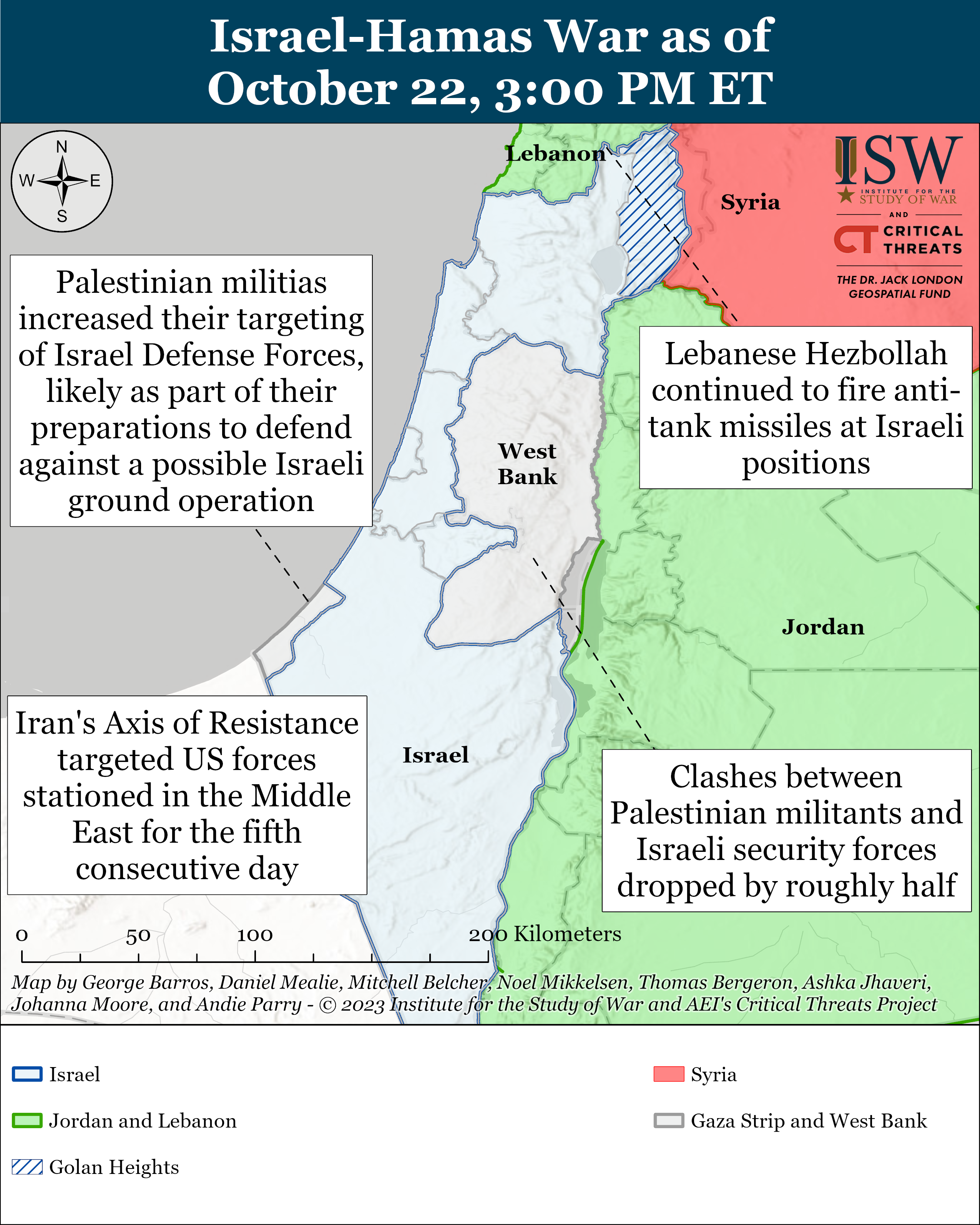
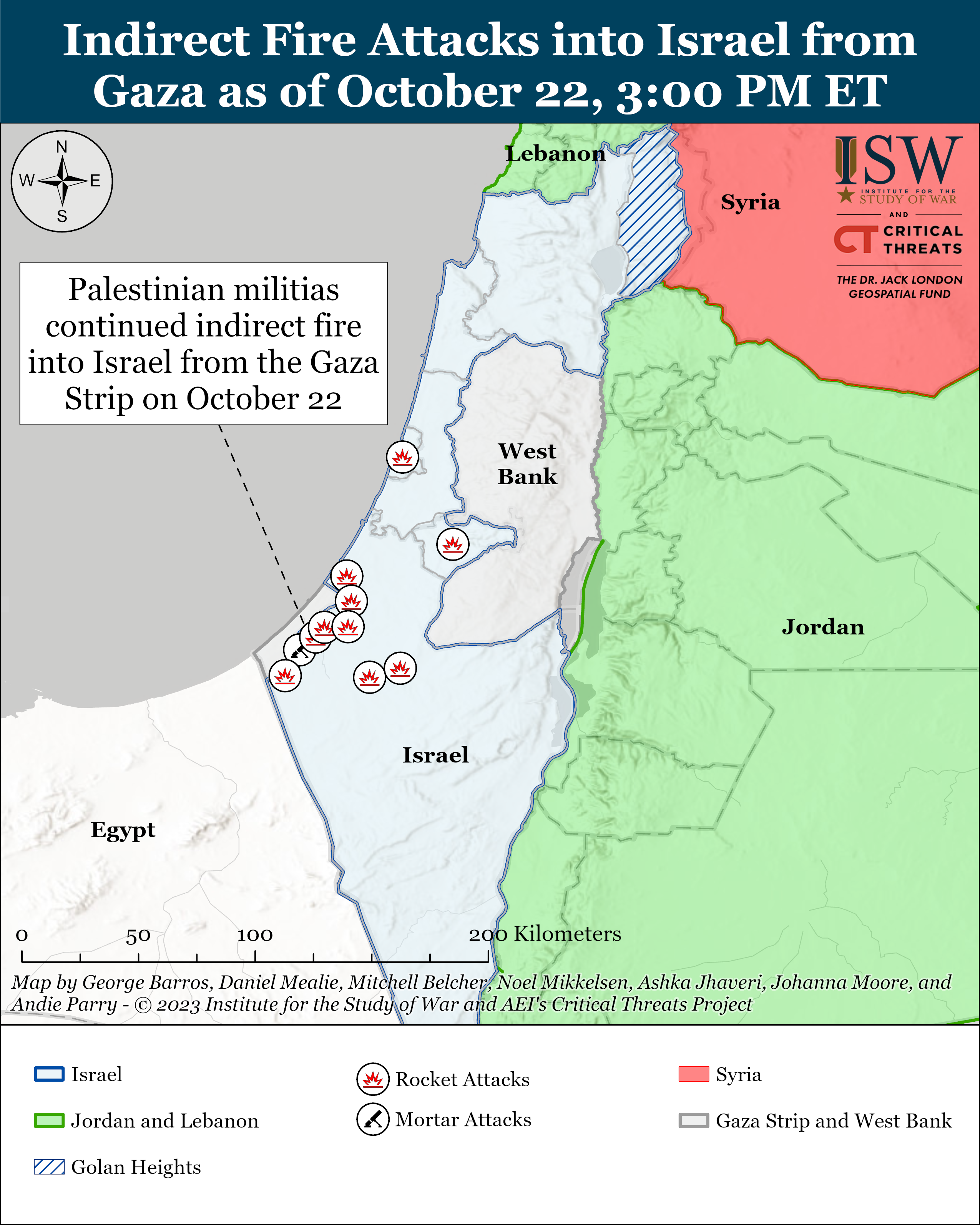
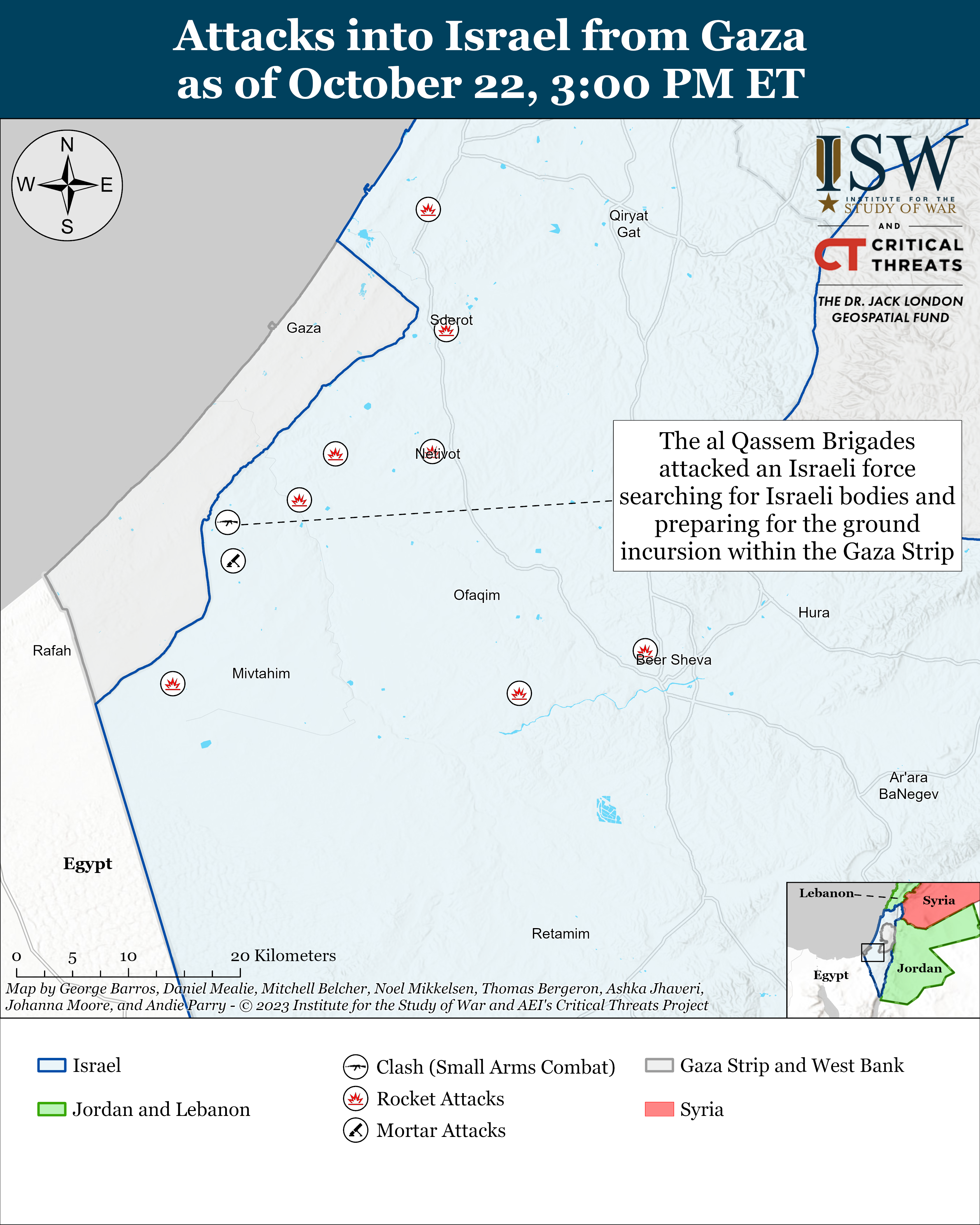
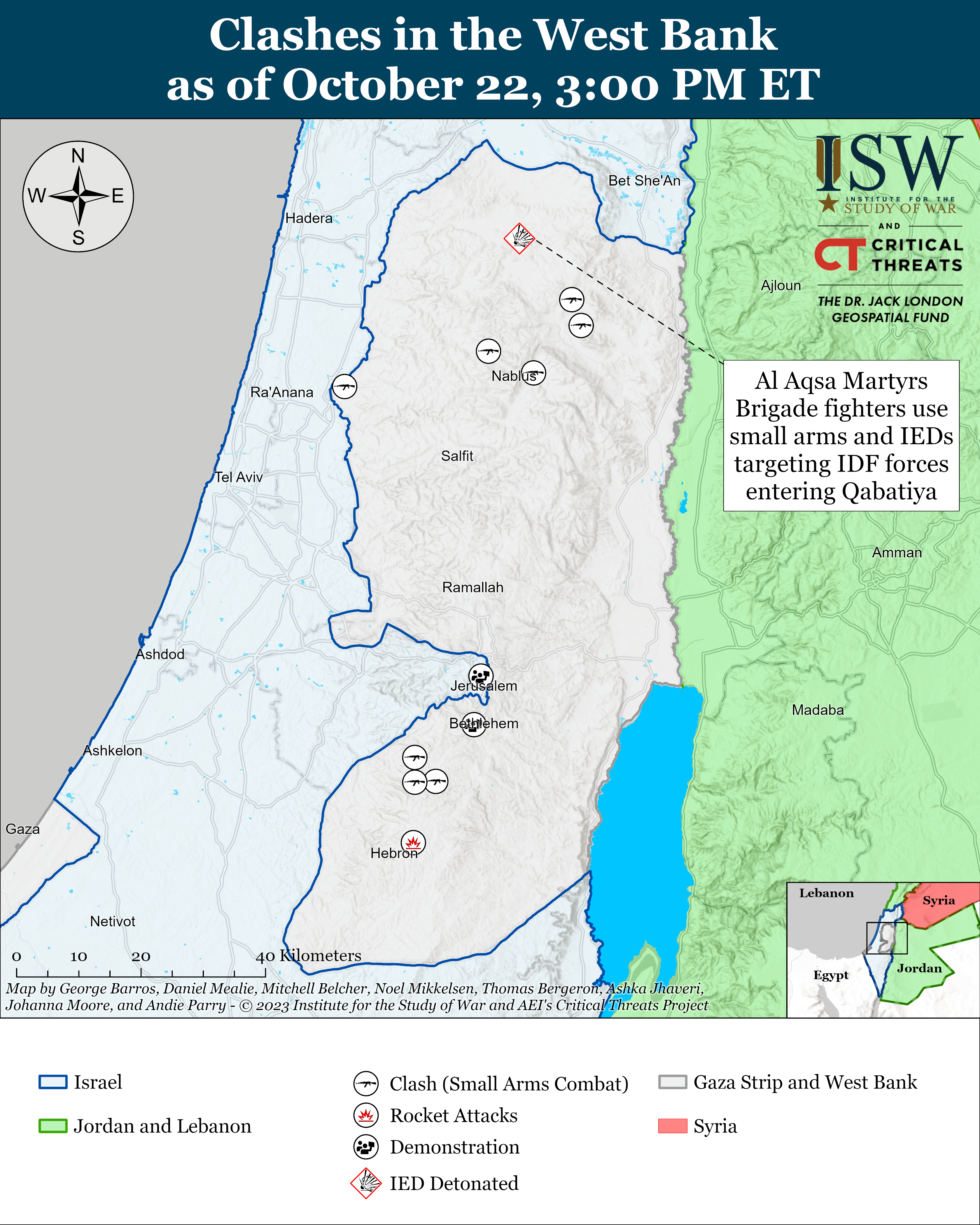
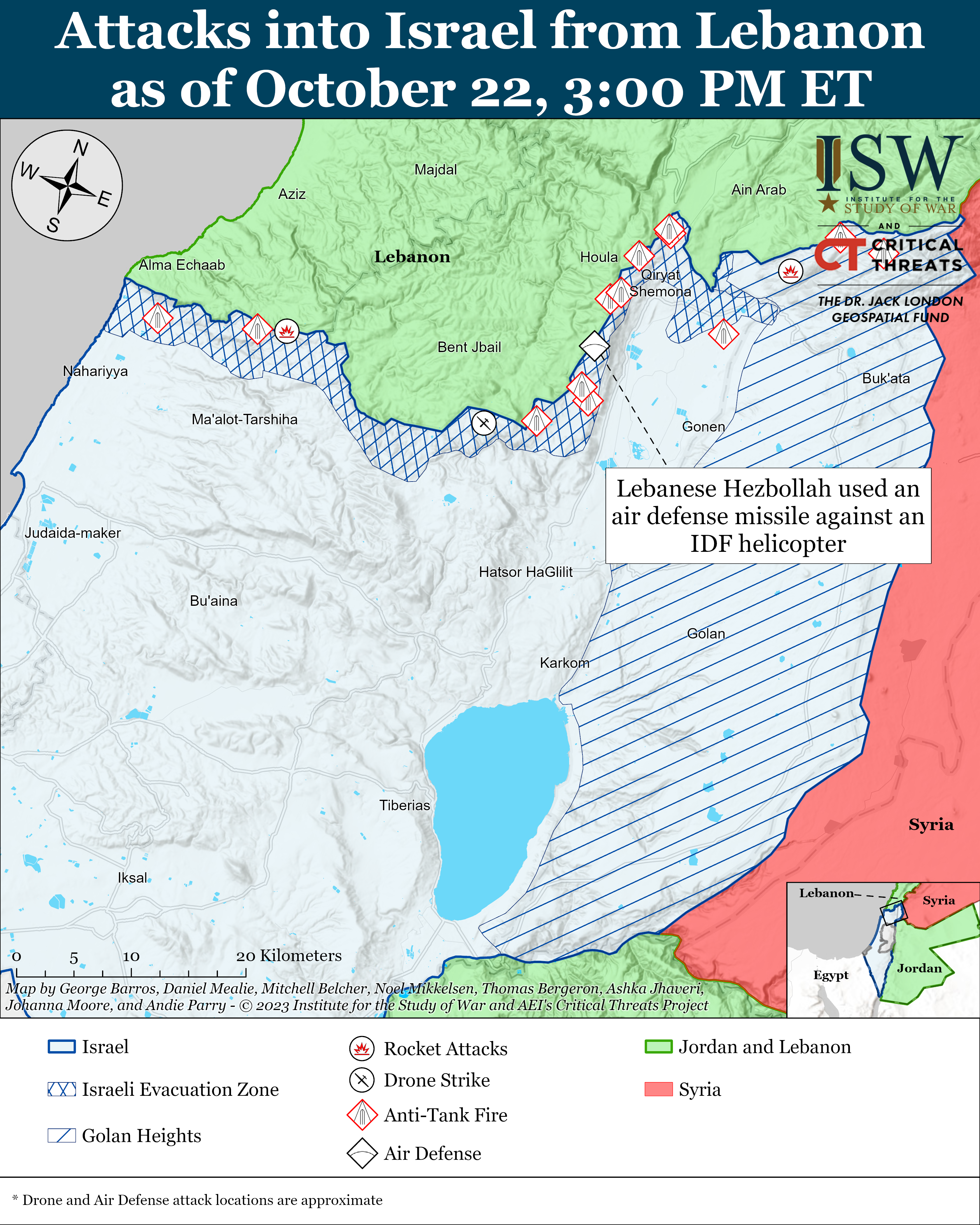
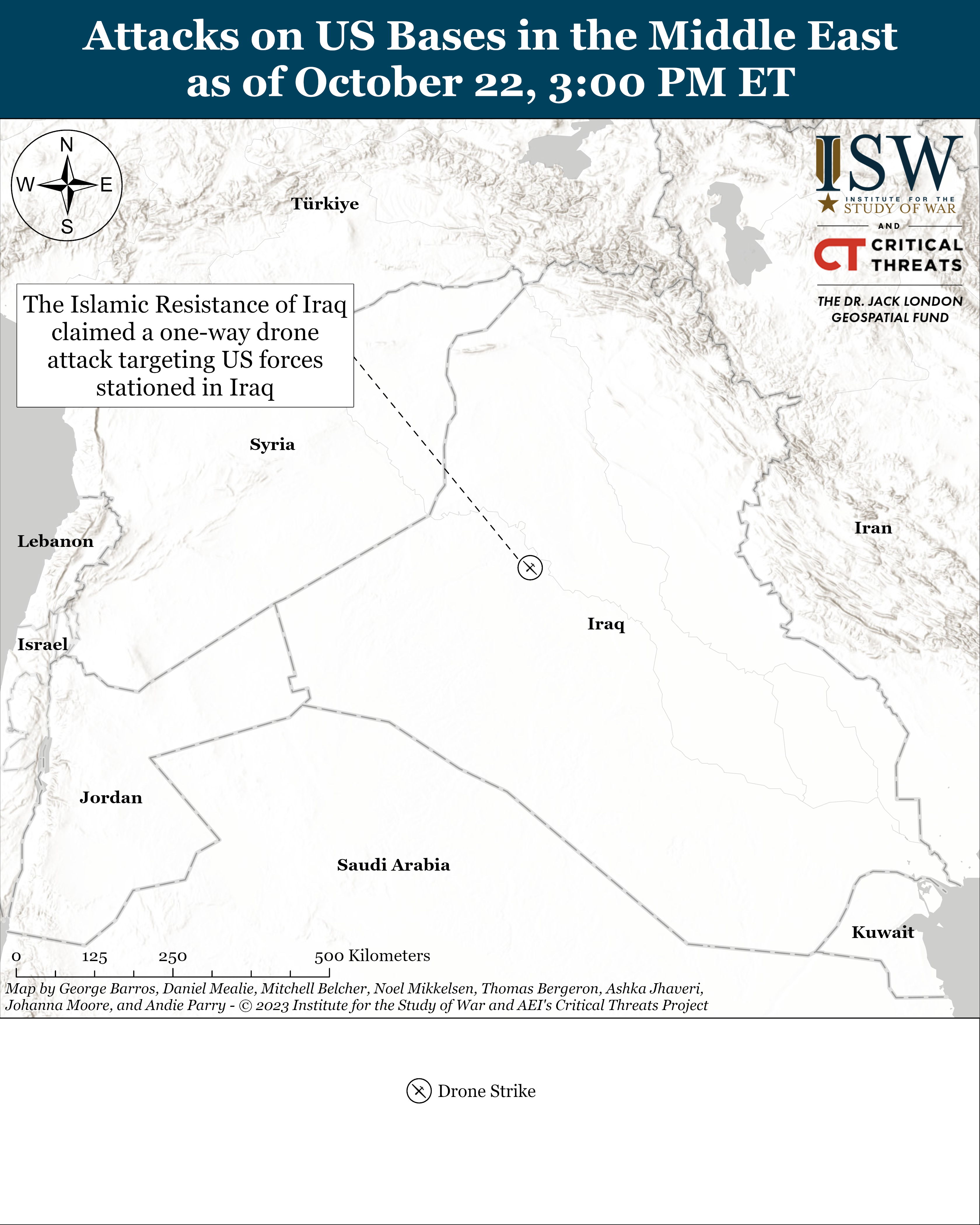
No comments:
Post a Comment